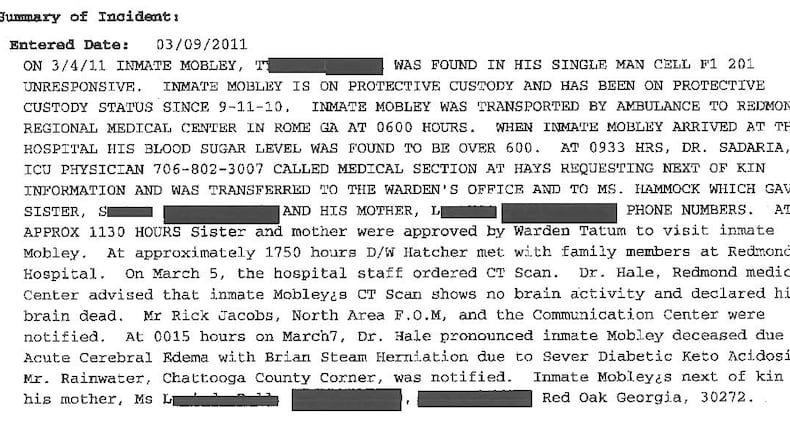An investigation by The Atlanta Journal-Constitution found that at least 12 inmates of Georgia jails or state prisons died in the past decade from diabetic ketoacidosis, a condition that is fatal only when diabetes is left untreated. Here are circumstances of their deaths.
Credit: HANDOUT
Credit: HANDOUT
Willie Whaley, 31, died at Georgia State Prison in December 2017. Whaley, a type 1 insulin-dependent diabetic since his youth, reported to the prison medical unit because of nausea and vomiting three days before his death, according to a notice last December in which his mother, Rebecca Hill, disclosed her intention to sue the state. He received insulin when he first went to the unit and again on the next day, but none over the next 48 hours, according to the notice. The end of the treatments coincided with a drug test that was positive for methamphetamines, the document states. The test was reportedly administered after Whaley laid down in the medical unit and began talking incoherently. Erratic behavior is a possible symptom of DKA, but Whaley was never referred to a physician, the notice says. Some diabetes drugs can cause a false positive for methamphetamine. An autopsy cited Whaley's history as a diabetic and a blood sugar reading approximately five times the normal range in identifying the cause of death as DKA.
Credit: HANDOUT
Credit: HANDOUT
Willie Green III, 41, died in October 2017 at Grady Memorial Hospital, four days after being transferred there from the Fulton County Jail. Green, a type 1 insulin-dependent diabetic since he was in his 20s, had been arrested eight days earlier on charges of criminal trespass and obstruction of a law enforcement officer at the downtown Greyhound bus station, where he was changing buses for a trip home to Simpsonville, S.C. Fulton County's chief jailer, Mark Adger, said Green's blood sugar was so high when he was booked into the jail that he should have been hospitalized then. Green was finally sent to Grady when his blood sugar was found to be four times the normal range and his body had become "ice cold," records show.
Credit: HANDOUT
Credit: HANDOUT
Micah Williams, 38, died in July 2016 at WellStar Kennestone Hospital after three days in the Cobb County Adult Detention Center. He had been jailed for failing to return for a court hearing following his arrest on charges of shoplifting two shirts from Abercrombie & Fitch. He was transferred to the hospital after he was found unresponsive near a toilet in the jail's infirmary with vomit, urine and feces around him, according to the autopsy report. The report said Williams had refused "any significant care" in the infirmary, including IV hydration. Williams, who lived in Cartersville, had not been diagnosed with diabetes, but he had been feeling poorly before he was booked into the jail, according to his father, Ralph Williams. The autopsy based the finding of DKA on Williams' blood sugar, which was five times the normal level, and a high concentration of acid in his blood.
Lindsey Ruffin, Jr., 58, died in January 2016 at Phoebe Putney Memorial Hospital in Albany, three days after being transferred there from Lee State Prison. According to the autopsy report, Ruffin had been exhibiting symptoms of DKA for at least a week before his death, including excessive thirst and urination. Members of Ruffin's family and others who knew him in his hometown of Augusta said they weren't aware that he was a diabetic. The autopsy didn't note Ruffin's blood sugar reading or the level of acid in his blood. The incident report provided to the AJC by the Georgia Department of Corrections was entirely redacted.
Credit: HANDOUT
Credit: HANDOUT
Wickie Bryant, 55, died in October 2015 at the Atlanta City Detention Center, 29 days after she was arrested for disorderly conduct at Atlanta Medical Center. When her body was discovered, she was found in full rigor with vomit on her face and on the bed. Bryant was a diabetic whose blood sugar was high when she entered the jail, but she never received proper dosages of her medication, according to a lawsuit filed by her sister, Mildred Sims.
Bryant had a history of mental problems and at times refused to take her medication during her stay in the jail, but that should have triggered referrals to a physician or hospitalization, the lawsuit contends.
Credit: HANDOUT
Credit: HANDOUT
Esteban Mosqueda-Romero, 63, died in January 2014, a day after he was transferred to Redmond Regional Medical Center in Rome from Hays State Prison. He was hospitalized after correctional officers and others noticed he was struggling with vomiting and had lost the ability to stand. At the hospital, his blood sugar was 1,472, nearly 13 times the normal range. During nine months in the prison system, Mosqueda-Romero never was treated for diabetes even though a blood sugar test when he entered the system indicated he had the disease. The physician who then served as the medical director at Hays State Prison, Dr. Monica Hill, subsequently acknowledged that Mosqueda-Romero's death would have been prevented had she and others paid closer attention to his medical records.
Credit: HANDOUT
Credit: HANDOUT
Douglas Brown, 41, died in October 2013 in the Fulton County Jail, where he had spent 10 days for allegedly falling behind in his child support payments. Throughout his time in jail, the Army veteran from College Park suffered with seizures and incontinence. When he was found dead on the floor of his cell, he was wearing an adult diaper, and there were traces of vomit on his face and on the floor. Brown's needs as a diabetic were noted when he was booked into the jail, but the jail's medical personnel frequently failed to make sure he got his medication or monitor his blood sugar, according to a lawsuit filed by his father, Robert Brown.
Credit: HANDOUT
Credit: HANDOUT
Paul Mullinax, 55, died in October 2013, a week after being booked into the Habersham County Detention Center for a probation violation. He was found unresponsive in his cell after two days of vomiting and falling down, according to evidence developed by the GBI and the Habersham County sheriff. Mullinax, a widower who lived in Alto, had been a type 2 diabetic most of his life and had managed the disease with two forms of insulin as well at the oral drug metformin. That information was written on the screening form completed when he entered the jail. What's more, his niece brought his metformin to the jail. Yet the only medication he received in the week before he died was one of the insulin drugs, records show. Lawyers for Mullinax's daughter, Brandy Teasley, drafted a lawsuit alleging negligence on the part of the doctor and nurse who were in charge of Mullinax's care as well as the company they worked for, Southern Health Partners Inc., but they didn't file it. Teasley said she agreed not to sue after the firm agreed to a confidential settlement.
Credit: HANDOUT
Credit: HANDOUT
David Fletcher Jr., 33, died in February 2012 in the Decatur County Jail seven days after being arrested for failing to pay child support. According to the autopsy report, the Bainbridge resident was found unresponsive with vomit on his face, legs, hands and feet. The report said Fletcher had behaved erratically in the days before his death, rubbing soap and deodorant all over his body and drinking the Epsom salt water he was using to bathe an infected toe. The report said Fletcher didn't have a known history of diabetes, but DKA was considered the cause of death based on his elevated blood sugar and the acid in his blood.
Credit: HANDOUT
Credit: HANDOUT
Stephen Thomas, 41, died in January 2012 at Smith State Prison. An autopsy concluded that he died from DKA because his blood sugar was nearly seven times the normal range and there was a high level of acid in his blood. The condition developed over a period of several hours, according to the death certificate. Thomas' sister, Shannon Thomas, said she didn't think he knew he had diabetes, although she suspected he might have the disease because he'd gained a lot of weight and he told her his feet were bothering him. He complained that "little needles" were in his feet, she said.
Credit: HANDOUT
Credit: HANDOUT
Tyrence Mobley, 34, died in March 2011, two days after he was found unresponsive in a single-man cell in the isolation-segregation unit at Hays State Prison. He was transferred to Redmond Regional Medical Center in Rome, but a CT scan showed no brain activity. At the same time, his blood sugar was tested and found to be six times what would be considered normal. A Georgia Department of Corrections incident report said Mobley had been in protective custody for nearly six months but didn't say why. Relatives said they didn't know Mobley was a diabetic and it's possible he didn't know himself. No autopsy was performed, according to the GBI.
Credit: HANDOUT
Credit: HANDOUT
Barnes Nowlin, Jr., 39, died in June 2008 after spending three days in the Whitfield County Jail for missing a hearing on a traffic case. The truck driver from Rome was a diabetic who took three kinds of oral medications. His wife brought his medications to the jail, but they weren’t given to him at all times, nor was his blood sugar tested on a regular basis, according to deposition testimony from a lawsuit that led to the county paying an $850,000 settlement. In the hours before Nowlin died, he was struggling with vomiting and had lost his ability to stand, but a jail nurse ignored requests to check on him, according to evidence developed by the GBI. In 2009, a coroner’s inquest labeled Nowlin’s death a homicide, but a criminal case wasn’t pursued.
The Latest
Featured
















